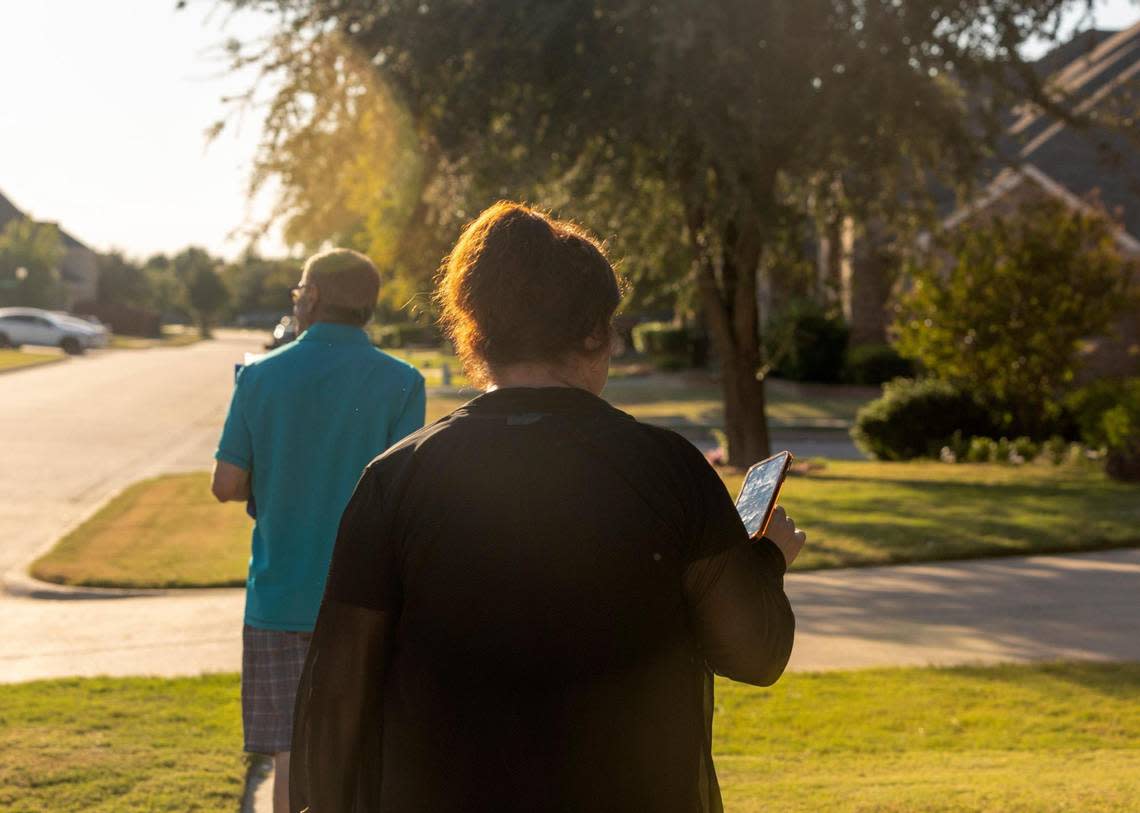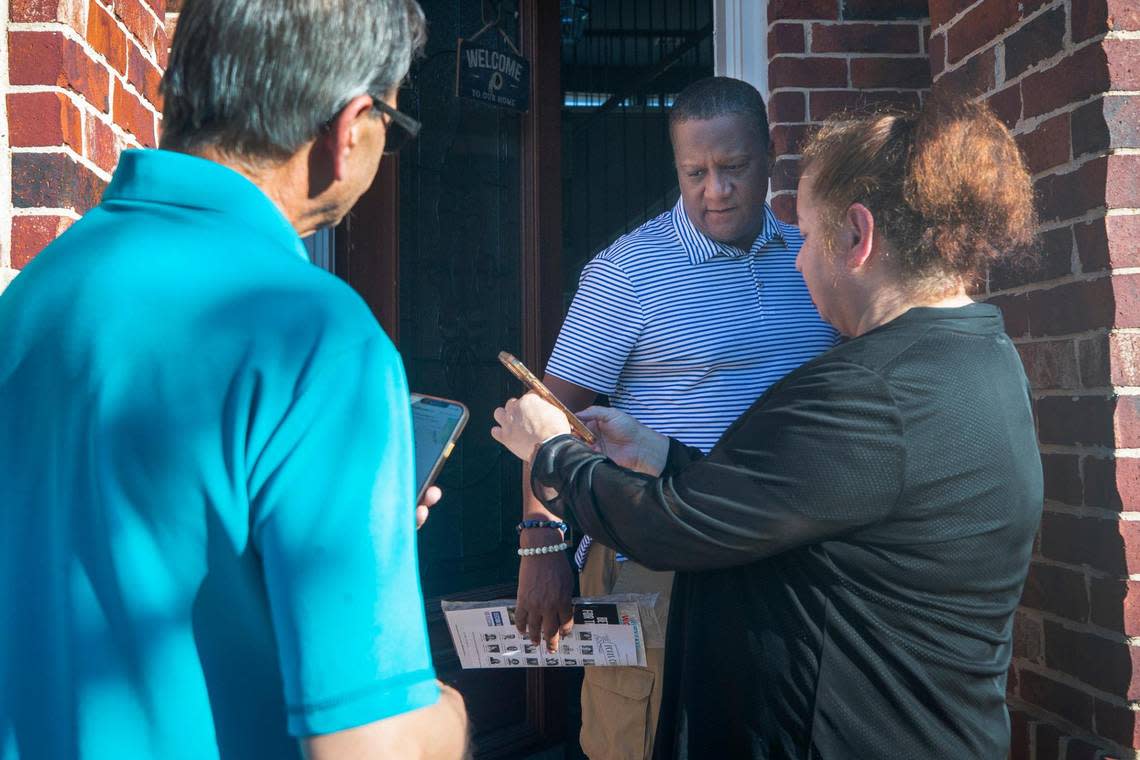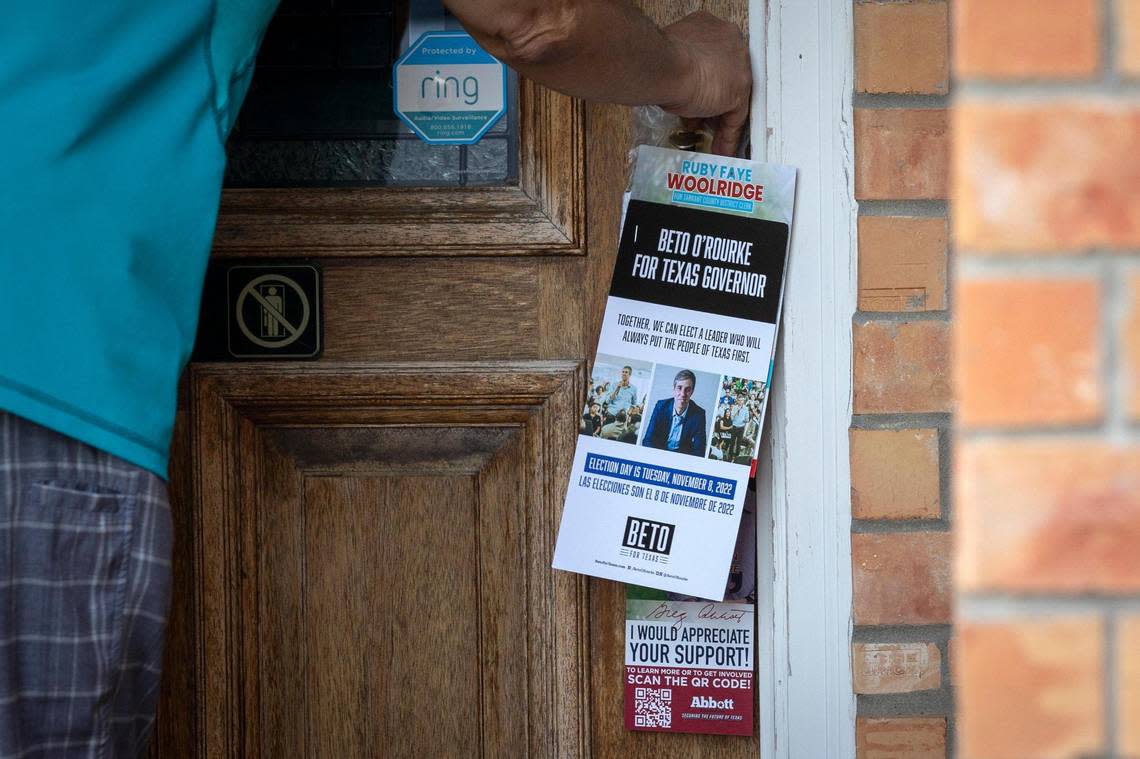In Tarrant County, elections are won in the suburbs. Can Democrats harness the power?
As the sun sunk toward the skyline over Arlington’s Cravens Park one Sunday afternoon, Nadia and Amjad Bhular waited in the parking lot for the crowd to come in.
Royal blue bags filled with plastic baggies of fliers for Democratic candidates filled the trunk of their silver Honda. They’d soon find their way to doorhandles around the precinct in south Arlington, which the Tarrant County Democratic Party has identified as a goldmine for potential blue votes.
In Tarrant County, there’s power to be found in suburbs like these. Tim O’Hare, Republican candidate for county judge, won his primary against former Fort Worth Mayor Betsy Price by mobilizing voters in north Tarrant suburbs, like his stomping ground in Southlake.
And it’s here in growing and diverse southeast Tarrant County, as well as Fort Worth’s south urban core, where the Democrats think the same success can be found in their path to flip Tarrant County blue Election Day Nov. 8, party chair Allison Campolo said.
Turnout in these areas has historically been low. Voters in and around northern suburban areas like Keller, Southlake, Grapevine and Colleyville showed up in droves to vote in the 2018 U.S. Senate race between current Democratic gubernatorial candidate Beto O’Rourke and Republican Ted Cruz. There were 66,000 more votes cast in the precincts north of Loop 820/Texas 183 than in the ones south of Interstate 20, according to a Star-Telegram analysis of voting data.
“When we activate those voters, those areas of color and those younger voters, I mean, that’s all going to go for Democrats,” Campolo said.
Take a look at an electoral map and you’ll find a few patches of blue in an otherwise red state in urban cores like Dallas, Houston, Austin and San Antonio. Fort Worth has historically been blue and gets bluer as it diversifies. It’s the suburbs around the nation’s 13th biggest city that consistently keep Democrats out of state and local offices.
But the Democrats are gearing up for change in 2022.

The Bhulars will soon be joined by a troupe of volunteers to knock on doors in the historically strong Democratic Arlington precinct. Among those who show up to volunteer are candidates themselves, like Democratic Precinct 2 county commissioner candidate Alisa Simmons and Democratic district attorney candidate Tiffany Burks.
They’ll each grab a partner, they’ll each grab a bag of fliers and they’ll each go out to accomplish the day’s goal: Reaching their voters.
As far as Craig Lee, a volunteer and new precinct chair for the Democrats, is concerned, Tarrant County is the battleground for the rest of the state.
“It is ground zero turning Texas blue,” Lee said. “I don’t believe there is a more important area in Texas for Democratic progress than Tarrant County. I believe this is, if there’s any movement in that direction, this is where it will start.”
The power of the suburb
In elections, results can come down to the answers to these questions: Who’s angry about what? Which party is reaching its voters? Who is getting their people to show up?
The suburbs are the battleground for Republicans and Democrats almost everywhere you look, said Jim Riddlesperger, professor of political science at TCU.
Suburbs used to be staunchly Republican, Riddlesperger said, but certain political issues like abortion and education levels of voters in the suburbs have changed the tide.
Since the suburbs have higher education and income levels, more people from the suburbs are likely to show up to the polls, Riddlesperger said.
In the suburbs, turnout can also depend on design.
Suburbs were designed to be exclusive, said Carrie LeVan, an assistant professor of government at Maine’s Colby College. Now that the working class and low income communities are being pushed out of cities and into the suburbs, they’re running into obstacles with all levels of civic engagement.
“We know that design can hamper turnout because it can either reduce or increase the cost of participation,” LeVan said.
Getting people in these communities to become more civically engaged comes down to canvassing efforts, which LeVan said can lead to 8% more turnout.
“They don’t have a lot of competing messages,” LeVan said. “They’re not getting mailers, they’re not getting phone calls. They’re not targeted. And so one contact by a canvasser can have really profound effects on these low propensity, low turnout voters who are more likely to be Latino, Hispanic, or African-American, Black-American and Asian-American.”

Whether the Democrats can replicate the success the GOP has seen in northern parts of the county is difficult question to answer, Riddlesperger said. North Tarrant voters are more likely to show up to the polls, and the area is historically well organized, he said.
While Democrats have clung to the idea that their people showing up can lead to a win, Riddlesperger said there’s mixed evidence to support the sentiment.
What holds the blue votes back?
The Bhulars have been working as a couple for the Democrats for years — Nadia works as the House District 101 coordinator and Amjad as a precinct chair. They got involved after retiring, traveling the world and seeing the effect politics had on the lives of everyday people.
Nadia and Amjad used to work on the ballot board, where Nadia said they saw hundreds of ballots in which voters only checked the box for who they wanted for president.
The local politicians, Nadia said, have more influence in your life than the president. To Amjad, there’s a lack of civic education.
And as the election approaches, the Bhulars say they have been block walking every day.
Democratic DA candidate Burks finds herself knocking on doors and meeting Democratic voters who think their vote doesn’t matter. Campolo believes Tarrant County’s redness comes down to reputation — blue voters think their vote won’t matter, so they choose not to cast it.

“The county has been Republican since I moved here,” Burks said. “And I think after a while that wears on people, you know. They’re like, ‘They keep winning.’”
Rick Barnes, Tarrant County’s GOP chair, said the party has been working across the county to secure red votes. Party officials have done heavy work in the northeast and southeast parts of Tarrant County, and they’ve hit the northwest due to the amount of growth in the area.
Barnes thinks the reason the suburbs stay so red is growth. Anecdotally, Barnes has found people move to Tarrant County because of its conservative reputation — and they’re landing in the suburbs. This political migration is why Barnes thinks the county keeps growing, too.
Issues that come across school board plates in Northeast Tarrant especially feed into these upcoming elections too, Barnes said.
Walking the block
The block walkers this particular Sunday were split into pairs. Each candidate for office left from the park with a partner who wasn’t running for office, and each pair was assigned a different part of the precinct, called a turf, to knock on doors and leave fliers.
This afternoon, precinct chair Lee paired himself with district clerk candidate Ruby Faye Woolridge, who previously ran for the Democratic nomination for Precinct 2 commissioner. She lost to Simmons.
Lee, clad in a dark gray O’Rourke shirt and black Nikes, hopped into his black Prius with all the essentials he needed. His white “Greetings from Texas!” tote was filled with candidate fliers, a clipboard to sign up volunteers and copies of absentee ballot applications to pass out to those who requested them.
As he drove to his assigned turf, Lee said it was intimidating working as a precinct chair for a county long touted as the last red urban county in the state, but in his experience knocking on doors and talking to people he’s found Tarrant County isn’t as red as people make it out to be.
In Lee’s mind, if Tarrant County flips blue, so does the nation.
When he and Woolridge arrive, they parallel park at the edge of the road and start on their way. Outgoing Woolridge does the talking, and Lee marks off the people they’ve spoken to where they’ve dropped off fliers.
The first house was a bust, and the pair left a stack of fliers behind.
It’s par for the course. Out of every five houses the pair hits, they might talk to one person, Woolridge said.
On the Sunday afternoon in Texas, Woolridge figured it was likely people were hopping between football games.
But not everyone’s watching a game. And on this day, this is the Democrats’ game to play.
